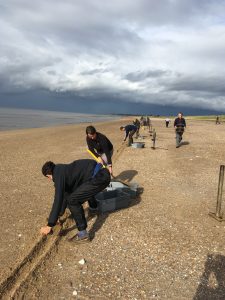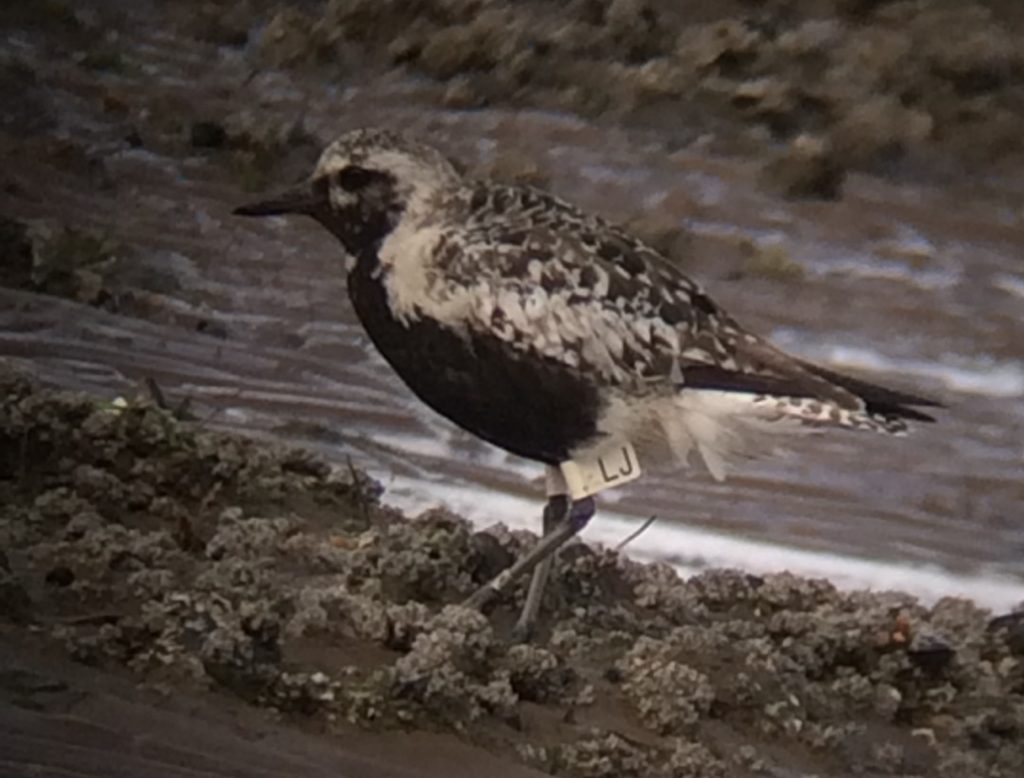Friday 27 September
The team assembled at the fieldwork base early evening and were treated to a supper of baked potatoes with vegetables followed by blackberry and apple crumble and custard. After supper Lucy gave a briefing outlining the options for the weekend. There was no catching option for Saturday morning due to the tide so it was agreed that this would provide a good opportunity for a major resighting effort by the team. Lucy had arrived at the fieldwork base on Thursday evening in order to undertake recces over the Friday tides. Lucy had around 1,000 Oystercatchers on the rising tide along Heacham beach on Friday evening which provided a good option for a catch on Saturday evening. There was also the option of a Turnstone catch on Heacham North North beach. Lucy and the team had several considerations to take into account including Lucy’s limitations on her cannon-net licence, the small size of the team and the less than favourable weather conditions with strong winds forecast for Saturday and rain on Sunday morning.
It was decided to aim for the Oystercatcher catch on Saturday evening, partly due the lack of available colour rings for Turnstone, leaving the Turnstone catch for a weekend later in the season when we could also add colour rings to the birds caught. Teams were agreed for the resighting on Saturday morning and the team enjoyed a reasonably early night.
Saturday 28 September
Three teams headed off on Saturday morning to catch the falling tide – one team to Heacham North North, one team to Snettisham beach and the third team to Snettisham Pits, returning to the fieldwork base at 11:00 for breakfast. The team from Snettisham Pits found very few birds on the Pits with just one small flock of Black-tailed Godwits at the southern end. The tide had already receded quite a way from the mudflats opposite the Pits thereby reducing opportunities for resighting. Further north along the beach at Snettisham, the tide was slow to uncover the sand and few birds came onto the exposed sand as the tide went out. Despite this, there was a reasonable number of Curlew flags read with a total of 56 sightings across the team. The Heacham NN team added 12 Turnstone sightings to Lucy’s 15 on Friday during her recce on the beach.
After the usual Wash breakfast, the team split into one group loading the trailer whilst others washed up and packed the food for a meal on the beach (between setting and catching) with a view to leaving the fieldwork base at 14:00 to set the cannon nets on Heacham beach. This provided an opportunity for the new people to see the cannon net equipment before it was loaded into the trailer and to begin to learn the names for the various pieces of equipment. The team left in three car loads. Slight delays were encountered by various unscheduled events including the trailer coming adrift from Lucy’s car (a Wash trip often involves a trailer mishap of some sort) and by difficulties with the newly acquired key to the track behind Heacham beach. After many attempts by Lou and others to open the padlock with the key, Lucy located a second padlock behind the gate which worked perfectly!
Three large mesh nets were set on the beach. Despite working efficiently, the team were working against the clock to be off the beach by 16:15, three hours before high tide, and the Oystercatchers were beginning to arrive. Several decoys were deployed in the catching area. Lucy was in firing position to the north of the nets with Gary to the south. The rest of the team had a fairly hurried picnic by the cars before getting into position behind the seawall with Lou organising the basecamp team.

The Oystercatcher flock came onto the beach some distance north of the catching area. Ben was dispatched to try to encourage the flock to move towards the catching area. Unfortunately, the birds had other ideas and headed off in the opposite direction towards Snettisham. The tide was moving quickly – Rob R and Chris were sent to the beach with instructions to change jump ropes to ‘half jumps’, an instruction which was quickly reassessed and changed to ‘no jumps’. No sooner had they returned than Cathy was sent to retrieve the decoys to prevent them getting wet and the decision was made to abort the catch. The equipment was quickly retrieved from the beach and the team returned to the fieldwork base. Although a catch was not made on this occasion, new members had the opportunity to experience the setting of a cannon net in daylight and to begin to understand the complexities involved in a catch.
The evening entertainment was provided by Lou in the form of a quiz. Not to be deterred by the groans of several members of the team, Lou researched some extremely obscure laws in various states of the USA. So, should you happen to be a single female, don’t decide to go skydiving on a Sunday (I can’t remember which state his applied to so maybe just choose another day). We also now know that Drosophila bifurca, though only a few mm long, produces sperm which are 5.8 cm long!
Sunday 29 September
The weather forecast for Sunday predicted rain, irrespective of the website consulted (of which there appear to be many). On this basis, several people decided to leave on Saturday evening with others leaving on Sunday morning. Six stalwarts chose to brave the weather in the quest for further flag sightings. These six were rewarded for their decision as, although some showers persisted for a while, most of the time on the beach was in the dry although the wind started to increase late morning. The Curlew and Bar-tailed Godwits moved onto the exposed sand as the tide dropped with a further 40 sightings made during a very enjoyable morning.
Monday 30 September
Cathy stayed at the fieldwork base on Sunday evening and enjoyed a real spectacle of thousands of Knot on the Pits on Monday morning. Cathy read a further 15 colour marks to add to the total resightings for the weekend.
Colour-ring resightings for the weekend:
| Species | Friday | Saturday | Sunday | Monday | Total |
| Curlew | 6 | 56 | 30 | 11 | 103 (61) |
| Bar-tailed Godwit | 8 | 8 (8) | |||
| Turnstone | 15 | 12 | 27 (16) | ||
| Grey Plover | 1 | 1 | 2 (1) | ||
| Redshank | 1 | 2 | 3 (3) | ||
| Black-tailed Godwit | 1 | 1 (1) | |||
| Avocet | 1 | 1 (1) | |||
| Oystercatcher | 1 | 1 (1) | |||
| Total | 21 | 70 | 40 | 15 | 146 (92) |
146 sightings of 92 individual birds was a good total for the weekend and a result of the hard work of the team in less than ideal conditions.
Sightings from schemes other than WWRG included the three Redshank (two from the Humber estuary and one from the River Orwell), one Avocet (from Cambridgeshire) and one Oystercatcher (from Norway)
Lucy was thrilled with the sighting of Grey Plover L J/W – her initials!

The quote of the weekend went to Rob R. ‘It’s easier to ask for forgiveness than for permission’ – said in relation to eating the last baked potato.
Thanks to Lucy for leading the trip, to Louise for organising the resighting and to the shoppers, cooks and washer-uppers.

